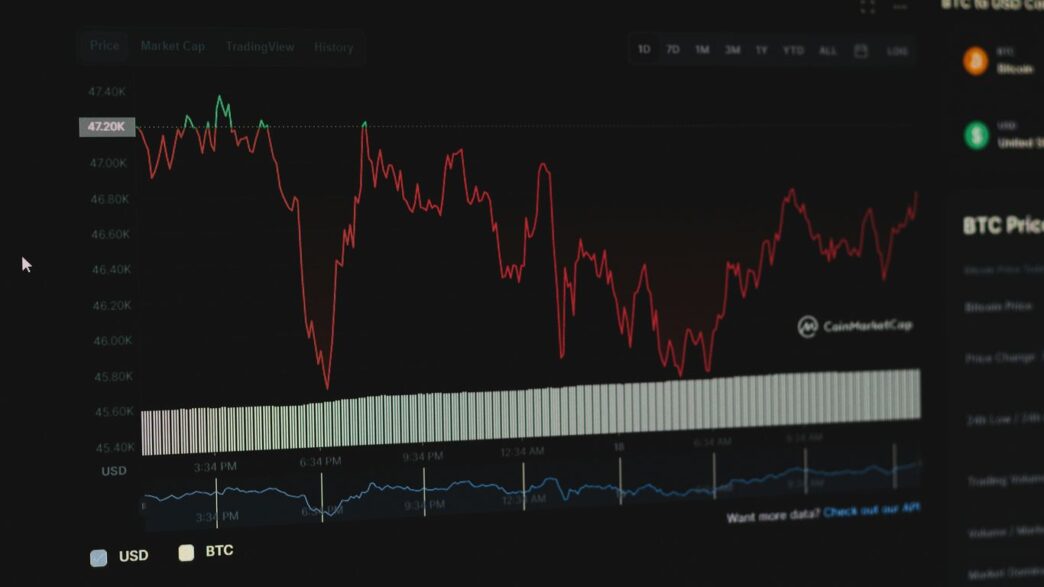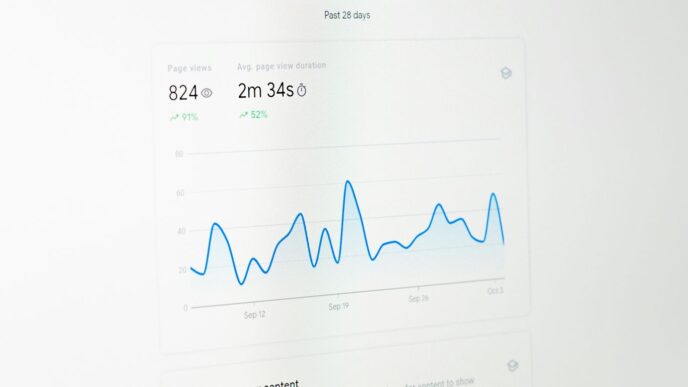Looking into microsoft stocks today, it’s always interesting to see how a big company like Microsoft is doing. They’re involved in so many things, from the Windows you use to the cloud services businesses rely on, and of course, their gaming division. It feels like they’re always up to something new, especially with all the buzz around AI lately. So, let’s break down what’s happening with MSFT right now and what people think might happen next. It’s a lot to keep track of, but it gives you a good idea of where the company stands.
Key Takeaways
- Microsoft’s stock is currently trading near its 52-week high and above its average price over the last 200 days, suggesting recent positive momentum.
- The company’s financial performance shows steady growth in revenue and net income, with strong profitability metrics.
- Analysts generally have a positive outlook on Microsoft, with many recommending ‘Buy’ or ‘Outperform’ ratings and setting price targets above the current share price.
- Microsoft is actively pursuing advancements in AI and cloud computing, which are seen as key drivers for its future growth and market position.
- While Microsoft is a leader in its field, it faces competition and must manage challenges like geopolitical shifts and supply chain issues.
Microsoft Stocks Today: A Snapshot Of Recent Performance
Alright, let’s take a look at how Microsoft’s stock, ticker symbol MSFT, has been doing lately. It’s always good to get a feel for the immediate performance before we dig deeper into the company’s financials and future plans.
Current Share Price And Daily Change
As of today, October 17, 2025, Microsoft’s stock is trading. The last closing price was $511.61, and since then, it has seen a slight dip of $1.82, which is about a 0.35% decrease. This kind of movement isn’t unusual for a stock of this size, but it’s worth noting.
Pre-Market Trading Activity
Before the market officially opened today, MSFT shares were already showing some action. The stock dropped an additional $3.20 in pre-market trading. This early activity can sometimes give us a hint about the sentiment heading into the main trading session.
52-Week Range And Moving Averages
Looking at the bigger picture, Microsoft’s stock has been trading within a range over the past year. The 52-week low was $344.79, and it has climbed up to $555.45. Currently, the stock is trading near the higher end of this range and is also sitting above its 200-day moving average. This suggests a generally positive trend over the last year, though recent dips are part of the ongoing market dynamics.
Here’s a quick look at some key figures:
- Last Close: $511.61
- Today’s Change: -$1.82 (-0.35%)
- Pre-Market Change: -$3.20
- 52-Week Range: $344.79 – $555.45
- Trading Today’s Range: $508.13 – $516.85
Analyzing Microsoft’s Financial Health And Growth
When we look at Microsoft’s financial standing, it’s pretty clear they’re doing well. The company has been consistently bringing in more money and making a good profit. It’s not just about the big numbers, though; it’s how they’re growing over time that really tells the story.
Revenue And Net Income Trends
Microsoft has seen steady growth in its total revenue over the past year, with a notable increase. This upward trend is also reflected in its net income, which has also grown. It seems like their various business segments, from cloud services to software, are all contributing to this positive financial picture. For instance, in Q4 FY25, the company reported a substantial revenue of $76.44 billion and a net income of $27.23 billion. This shows a strong performance in the most recent quarter, building on the year’s overall success.
Earnings Per Share Performance
Earnings per share, or EPS, is another key indicator of how profitable a company is on a per-share basis. Microsoft’s diluted EPS has also been on the rise. This means that for every share of stock, the company is generating more profit. This is good news for shareholders as it often translates to a higher stock value over time. The numbers show a healthy increase year-over-year and even a slight bump quarter-over-quarter, which is a good sign.
Profitability Metrics And Margins
Looking at profitability, Microsoft is performing strongly. Their profit margin is quite healthy, meaning they keep a good chunk of their revenue as profit after covering all their costs. Furthermore, the return on assets and return on equity are also impressive. These metrics suggest that Microsoft is very efficient at using its assets and shareholder investments to generate profits. A solid profit margin of 36.15% and a return on equity of 33.28% indicate a well-managed and financially sound company.
Analyst Perspectives On Microsoft Stocks Today
When you look at what Wall Street thinks about Microsoft stock, it’s pretty interesting. Most of the time, analysts are giving it a thumbs up, leaning towards a ‘Moderate Buy’ recommendation. This isn’t just a random guess; it’s based on a lot of digging into the company’s numbers and its place in the market.
Here’s a quick look at what that means:
- Buy: Analysts believe the stock price will go up significantly from its current level.
- Hold: They think the stock price will stay relatively stable, performing in line with the market.
- Sell: Analysts suggest the stock price is likely to decrease.
Right now, the general feeling is positive, with a consensus pointing towards a ‘Moderate Buy’. This suggests that a good number of analysts see potential for growth, even with the stock trading near its 52-week high. They’re watching things like Microsoft’s AI advancements and its strong cloud business very closely.
Of course, not everyone agrees 100%. There are always a few who might be a bit more cautious, but the overall trend from analysts is one of optimism about Microsoft’s future. It’s always a good idea to check out the latest ratings and price targets to get the most up-to-date picture of what the experts are saying about Microsoft stock.
Microsoft’s Strategic Initiatives And Market Position
Microsoft isn’t just sitting back; they’re actively shaping their future, especially with big pushes in AI and cloud computing. It feels like every other announcement is about a new AI feature or an expansion of their Azure cloud services. This focus is really about staying ahead of the curve and making sure their products are what people need now and down the road.
AI And Cloud Computing Advancements
The company’s investment in artificial intelligence is pretty significant. They’re integrating AI across their product lines, from the familiar Office suite to their cloud infrastructure. Think about Copilot, for instance – it’s designed to help users be more productive by assisting with tasks like writing emails, summarizing documents, and even generating code. On the cloud side, Azure continues to be a major player, competing fiercely and constantly adding new capabilities to attract businesses looking to move their operations online. This dual focus on AI and cloud is a big part of their long-term AI strategy.
Collaborations And Product Innovations
Beyond their internal efforts, Microsoft is also busy with partnerships and new product ideas. They’ve been making moves in areas like healthcare, working with other companies to bring their technology to new markets. It’s not just about software anymore; they’re also looking at hardware, like their Surface devices, and how they can innovate there. This constant stream of new ideas and collaborations helps keep their product lineup fresh and relevant.
Geopolitical And Supply Chain Considerations
Of course, it’s not all smooth sailing. Like many big tech companies, Microsoft has to deal with global issues. Geopolitical tensions can affect how and where they do business, and supply chain hiccups can impact the production of their hardware. They’re also keeping an eye on regulations that might affect their operations. It’s a complex world out there, and navigating these challenges is part of the daily grind for a company of this size.
Microsoft’s Competitive Landscape And Valuation
When we look at Microsoft’s place in the market, it’s pretty clear they’re a giant. Their market capitalization is massive, putting them in the mega-cap category. This means they’re a huge player, not just in software but across the tech industry.
Market Capitalization And Industry Standing
Microsoft’s market cap sits at a staggering $3.803 trillion as of October 2nd, 2025. This figure alone places them firmly in the ‘mega-capitalization’ tier, indicating their significant influence and scale within the technology sector. They operate across various segments, including Productivity and Business Processes (think Office, LinkedIn), Intelligent Cloud (Azure, server products), and More Personal Computing (Windows, Xbox, Surface). This broad reach across different areas of technology is a big part of why they’re so dominant.
Key Valuation Metrics
Looking at valuation, Microsoft’s trailing P/E ratio is around 37.81, and the forward P/E is about 33.33. The Price/Sales ratio is 13.67, and the Price/Book ratio is 11.16. These numbers give us a snapshot of how investors are valuing the company relative to its earnings, sales, and assets. It’s worth noting that some analyses suggest Microsoft’s current share price of $510.96 might be considered overvalued, potentially sitting about 41.9% above its fair value based on certain popular valuation models. This is something to keep an eye on as the stock moves.
Comparison With Industry Peers
When you stack Microsoft up against other big tech companies, you see some interesting comparisons. For instance, while Microsoft has a market cap of $3.803T, other major players in the Software—Infrastructure space, like Oracle and others, have market caps in the hundreds of billions. This highlights Microsoft’s sheer size. Their performance over the last year, showing a 22.05% return compared to the S&P 500’s 12.71%, also indicates strong recent growth. However, comparing specific metrics like P/E ratios and other valuation multiples against competitors helps paint a fuller picture of where Microsoft stands in terms of investor expectations and market sentiment. It’s a complex picture, with Microsoft often trading at a premium due to its market leadership and diverse business lines, including its significant investments in AI and cloud computing.
Future Outlook For Microsoft Stocks Today
Looking ahead, Microsoft (MSFT) seems pretty well-positioned, but like anything in the stock market, it’s not without its bumps in the road. The company’s big bets on AI and cloud computing are really paying off, and that’s expected to keep driving growth for a while. Think about how much businesses rely on Azure and Microsoft’s AI tools now – it’s hard to imagine that slowing down much.
Long-Term Growth Prospects
Microsoft’s future growth looks solid, mainly thanks to its dominance in cloud services and its aggressive push into artificial intelligence. Azure continues to be a major player in the cloud market, competing strongly with other big names. On the AI front, Microsoft is integrating these technologies across its entire product suite, from Office to its search engine, which should open up new revenue streams and keep customers engaged. They’re also making moves in areas like gaming with Xbox and in healthcare technology, which could add more layers to their business.
- Cloud Computing: Continued expansion of Azure services and hybrid cloud solutions.
- Artificial Intelligence: Integration of AI across all products and development of new AI-powered services.
- Gaming: Growth in Xbox Game Pass subscriptions and cloud gaming.
- Enterprise Software: Ongoing demand for Office 365 and Dynamics 365.
Potential Risks and Opportunities
Of course, it’s not all smooth sailing. There are always risks to consider. Increased competition in the cloud and AI spaces is a big one. Regulatory scrutiny, especially around AI and data privacy, could also become a factor. Geopolitical issues can affect global operations and supply chains, which we’ve seen impact tech companies before. On the flip side, there are big opportunities. Microsoft could really capitalize on the ongoing digital transformation across industries. Plus, their ability to adapt and innovate, as they’ve shown over the years, means they can likely find new ways to grow that we haven’t even thought of yet.
Key Considerations:
- Competition: Intense rivalry in cloud and AI markets.
- Regulation: Potential for stricter rules on AI and data usage.
- Economic Downturns: Impact on business spending and technology adoption.
- Innovation: Opportunities in emerging tech and new market segments.
Impact of Emerging Technologies
Emerging technologies are where things get really interesting. Beyond AI, think about advancements in quantum computing, the metaverse, or even new ways of interacting with devices. Microsoft is actively investing in research and development across many of these areas. While some of these might be longer-term plays, they represent potential future growth engines. Their ability to integrate these new technologies into their existing ecosystem will be key to maintaining their market leadership. It’s a dynamic landscape, and Microsoft’s track record suggests they’ll be a significant player in whatever comes next.
Wrapping Up: What’s Next for Microsoft?
So, looking at everything, Microsoft (MSFT) seems to be holding its own. The stock’s been pretty stable, trading near its yearly high, which is a good sign. They’re clearly making moves in AI and healthcare, and that’s got people talking. While there are always ups and downs, like that small dip we saw today, the company’s overall performance and its place in the market look pretty solid. It’s one of those companies that just keeps adapting, and that’s usually a good bet for investors. We’ll have to keep an eye on how their AI push and other ventures play out, but for now, MSFT is definitely a stock worth watching.
Frequently Asked Questions
What is Microsoft’s stock doing today?
Today, Microsoft’s stock price has seen a small drop. It’s trading a little lower than it did when the market closed yesterday. Overall, it’s still pretty close to its highest price over the last year.
How is Microsoft doing financially?
Microsoft is doing well financially. Their sales, called revenue, have been going up over time. They also make a good amount of profit, meaning they earn more money than they spend.
What do experts think about Microsoft’s stock?
Many experts, called analysts, think Microsoft’s stock is a good investment. They often give it ‘buy’ or ‘outperform’ ratings and set price targets that are higher than the current stock price.
What new things is Microsoft working on?
Microsoft is focusing a lot on artificial intelligence (AI) and cloud computing. They are also creating new products and working with other companies to bring new ideas to life.
How does Microsoft compare to other companies like it?
Microsoft is one of the biggest companies in its field. When you compare it to similar companies, it often stands out because of its large size and strong performance.
What could happen with Microsoft’s stock in the future?
Microsoft has good potential for future growth, especially with its work in AI and cloud services. However, like any company, there are always some risks and things that could affect its stock price.














